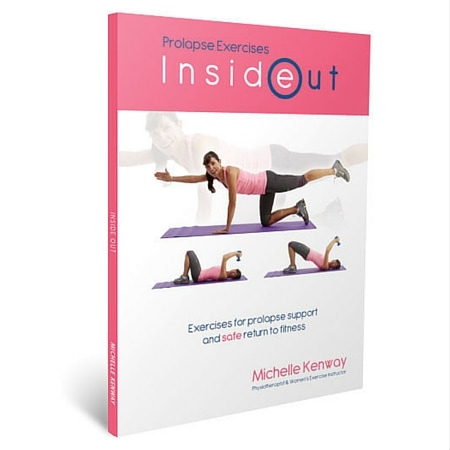
Should you modify or avoid Planking exercise?
Is The Plank safe for your pelvic floor?
There’s a great deal of confusion about the safety of Planking exercise for women with prolapse and after pelvic surgery.
Prolapse Exercises e-Book
International best selling prolapse exercise guide for women with prolapse and after prolapse surgery.
Prolapse Exercises teaches you how to:
- Exercise safely after prolapse surgery
- Reduce your risk or repeat prolapse
- Avoid unsafe exercises
- Choose pelvic floor safe exercises
- Reduce your risk of prolapse worsening
- Improve prolapse support
- Increase your strength and fitness
- Strengthen your core
- Lose weight
Read on now to learn:
- What Planking is
- Prolapse symptoms with the Plank
- Who should be cautious doing Planking exercise
- Latest research into abdominal curl exercises and pelvic floor
- How to modify the Plank
- When to avoid Planking

1. What is Planking Exercise?
Plank is a core strength exercise that typically involves supporting the body weight above the ground by weight bearing through the forearms and feet with the trunk.
Which Muscles Are Strengthened?
Planking exercise aims strengthen the muscles around the trunk that support the spine; the abdominal and spinal muscles in particular.
Additional muscles are strengthened during this exercise including muscles of the shoulder girdle, chest, middle back, thighs and calves.

2. Prolapse Symptoms With Plank
Some (not all) women with prolapse problems say that Planking exercise reproduces some of their prolapse symptoms including:
- Vaginal heaviness
- Bulging
- Dragging.
These symptoms may occur during the Plank and sometimes for days afterwards.
Women that tend to report symptoms with the Plank include women with:
- Moderate-severe prolapse
- History of prolapse surgery
- Pelvic floor weakness
- Body weight problems
3. Who Should Be Cautious Doing The Plank?
You need to be cautious doing Planking exercises if any of these risks apply to you:
- Prolapse
- After prolapse surgery
- Pelvic pain conditions
- Weak or poorly functioning pelvic floor muscles
- Previous childbirth
- Overweight.
4. Latest Research Into Abdominal Curl Exercises
New research1 confirms that the pelvic floor moves downwards when exercising women perform abdominal curl exercises (shown below).
This downward pelvic floor movement was found to be significantly greater in women who had given birth when compared with those who had not.

The Plank and abdominal curl exercises both involve strong contractions of the outer abdominal muscles including the ‘6 pack’ muscles. These strong outer abdominal muscles are known to increase pressure within the abdomen down onto the pelvic floor.
What This Research Suggests For Intense Abdominal Core Exercises With Prolapse
If your pelvic floor moves down, so too does your prolapse. Repeated downward or forceful movement of prolapsed tissues could forseeably cause prolapse symptoms and perhaps worsen prolapse severity.
This is why intense core abdominal exercises including abdominal curls or Planking are inappropriate for women with prolapse problems.
5. How To Modify Planking
Modifying the Plank may allow some women to perform it without experiencing prolapse symptoms.
Planking exercise can be modified by:

- Kneeling rather than weight bearing through your feet and forearms (shown above)
- Activating the abdominal muscles gently rather than forcefully
- Activating the pelvic floor muscles throughout the exercise
- Avoiding too many repeated Plank exercises
- Doing short duration Planking exercises – the ideal length of time to hold the Plank exercise is different for every woman
- Avoiding this exercise with your forearms on an unstable surface i.e. exercise ball
When Should You Avoid Planking Exercise?
Unfortunately modifying Plank exercise doesn’t always make it appropriate core exercise for all women.

Choose an alternative pelvic floor safe abdominal exercise if:
- Plank exercise reproduces your pelvic floor symptoms
- Your pelvic floor is weak
- You’ve had prolapse surgery
- You’re pregnant
- You’ve recently given birth
- You strain with effort
- You’re overweight
There are numerous pelvic floor safe core abdominal exercises that will help you tone your core and protect your pelvic floor from injury.
Key Points For Planking Exercise
- Planking is an intense abdominal core exercise
- Recent research confirms that abdominal curl exercises cause greatest downward movement in the pelvic floor who have given birth
- Planking exercise can be modified to a manageable level of pelvic floor loading in some women with prolapse
- Some women report increased prolapse symptoms associated with modified Plank – these women will likely benefit from avoiding Plank exercise in favour of alternative pelvic floor safe abdominal exercises.
Further Information & Videos
» 3 Pelvic Floor Safe Core Exercises
1Barton, Serrao, Thompson & Briffa. Transabdominal ultrasound to assess pelvic floor muscle performance during abdominal curl in exercising women. Int Urogynecol J. 2015 Jul 28. http://www.ncbi.nlm.nih.gov/pubmed/26215905











